|
1.
CENTRAL/ WEST AFRICA
Stable price trends continue amid slow exports
European buyers have become more cautious over the past
two months because of tighter availability of credit in
financial markets. This has been rather more marked in
UK than Continental Europe. Some UK timber buyers are
tending to avoid longer term commitments in favor of
purchases only against firm orders or to renew modest
stockholding. Others report stronger demand and many
traders have been reporting improvements in profitability
last year.
Demand for China and India was still at a high level and
almost all prices for logs and lumber were unchanged
through March. Price adjustments reflected changes in
demand for particular species rather than any overall
weakness in the market. Price drops included azobe, down
EUR15m3 for LM and B grades and EUR30 lower for
BC/C grade on falling demand from Netherlands, while
slowing demand for douka/makore by buyers for China
resulted in fairly heavy falls of EUR30 for LM and
EUR46 for B grade. Andoung was also down EUR15 for
LM and B grades while okan continued the recent
variations in price with plunges of EUR53 for LM and B
grade and EUR46m3 for BC/C. Dabema and andoung
rouge showed slight gains, both up by EUR15m3 for LM
and B grades. Although European demand for iroko had
tended to subside in the past two months, prices have held
firm and unchanged as supply was only moderate and
producers were prepared to reduce felling if demand was
lower rather than to cut prices.
West African producers and exporters noted that Far East
prices were firm and producers were asking for higher
prices as a result of increased freight costs. This meant that
South American exporters were able to compete only with
a very limited volume of few species. As a result, although
some European buyers were nervous, none were seriously
forecasting any overall price weakness. Additionally,
Ghana timber exports rose by 17% last year and seemed
set for ongoing sound performance through 2008. Demand
for Ghana sawn wawa lumber was reported as particularly
strong.
Some European buyers have hinted that prices for sapele
and sipo are lower but this seems to be rather wishful
thinking and not to be a situation recognized by exporters.
There were no reports of lower offers while demand
continues to be very brisk. There were no lumber prices
rises and while the majority of species have remained
stable, some weaknesses have developed at the end of the
month: moabi GMS was down EUR20 to EUR610 and
scantlings down EUR15 to EUR630. Padouk FAS GMS
dropped EUR15 to EUR585 and scantlings were down
EUR20 to EUR610.
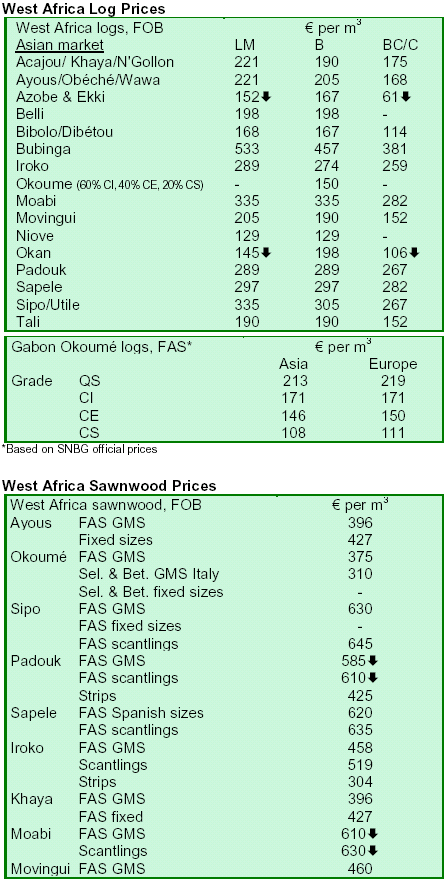
2. GHANA
Ministry opens bidding for seized teak
The Ministry of Lands, Forestry and Mines has invited
applications for pre-qualified competitive bidders for
seized teak plantation timber from the Bomforbiri Wildlife
Sanctuary. An estimated total volume of 979,186m3 from
2,810 logs are to be auctioned in the bidding process.
According to local news sources, the selection criteria for
bidders is based on the following:
Applicant should be an existing company with a forestry
business record of at least four years and registered with
the Registrar-General Department and the Forestry
Commission (FC),
Applicant should be up-to-date with payment of
stumpage fees, annual rents and any other forestry fees,
Applicant should be up-to-date with payment of income
tax or corporate tax, whichever is applicable
Applicant should possess a valid Social Security
Clearance Certificate
Applicant should not have been convicted of or have
admitted to committing two or more breaches of any
forest or timber industry law or regulation in the last two
years.
In TTM 13:4 (16-29 February 2008), it was reported that
the Minister for Lands, Forestry and Mines directed the
FC of Ghana to revoke the license of Royal Visage for
illegally harvesting teak in the Bomfobiri Wildlife
Sanctuary and seize the harvested teak. The statement
further directed a four-member task force to oversee the
removal of such logs to a convenient place for auction to
any company of good standing with the highest bid offer.
Messrs Royal Visage was disqualified from participating.
Local wood manufacturers lodge appeal to TIDD
Local wood manufacturers in the Techiman Municipality
of the Brong Ahafo region have complained about the
rising cost of lumber, saying the situation has been
keeping carpenters and furniture makers out of business.
They attributed the rising costs to activities of lumber
exporters, appealing to the government to take a second
look at exporters¡¯ operations.
In an interview with the Ghana News Agency, Mr Owusu-
Ameyaw, managing director of a local construction
company said the situation was also affecting the
construction industry, which employed a high number of
people and added that the current problem had forced
some employers to reduce their work-force. He bemoaned
the high cost of taxes and electricity tariffs and urged the
government to fashion out a policy to support the local
wood industry.
In another development, fears have emerged over the
rising cost of lumber and the possible collapse of
businesses in the not too distant future. The Woodworkers
Association of Ghana (Ashanti Branch) have decided to
embark on afforestation activities to address the threat of a
lumber shortage. This was the recommendation of a
survey carried out by the Association as part of its
advocacy programme sponsored by the Business Sector
Advocacy Challenge (BUSAC) Fund. At a news
conference in Kumasi, the Association appealed to the
Timber Industry Development Board (TIDD) of the FC to
design a programme that would provide their members
with the necessary information on plantation development.
Mr. Raynolds A Debrah, Regional Chairman of the
Woodworkers Association, said it had officially submitted
its recommendations to TIDD. The association was also
consulting with the FC in order to obtain parts of the
degraded forests for the plantation projects to help the
association meet its quota for regenerating degraded
forests.
Inflation levels rise sharply in February 2008
Official figures released by Ghana Statistical Services
(GSS) have revealed a steady rise in electricity tariffs
coupled with higher food prices, which has pushed
Ghana¡¯s inflation rate in February 2008 up to 13.20%, the
highest level since 2007. Meanwhile, prices for
agricultural commodities have risen sharply in both
developed and emerging markets in recent months.
In other news, rains are expected to start rather early this
year and domestic mills may encounter difficulties in log
supply earlier than usual, thereby affecting log stocks at
the mills.
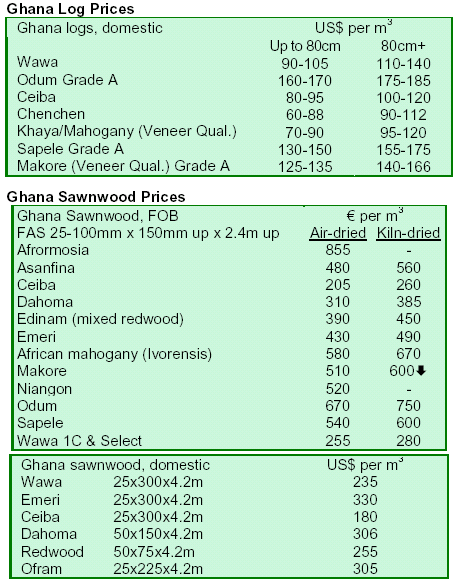
3.
MALAYSIA
Malaysian timber sector pins hopes on Japan imports
Prices of Malaysian timber products increased
substantially as shortages of raw materials became critical
as a result of tropical thunderstorms. Barring bad weather,
it remains to be seen if there are sufficient strong business
fundamentals in the international business environment to
lift up the Malaysian timber market in the long run.
However, two foreign brokerages, Merrill Lynch and
Credit Suisse have issued calls to upgrade the timber
sector, according to StarBiz. Prices of plywood have hit
bottom and Japanese regulatory bodies are relaxing some
rules and regulations concerning the Japanese construction
industry. This may help accelerate timber trade with
Japan.
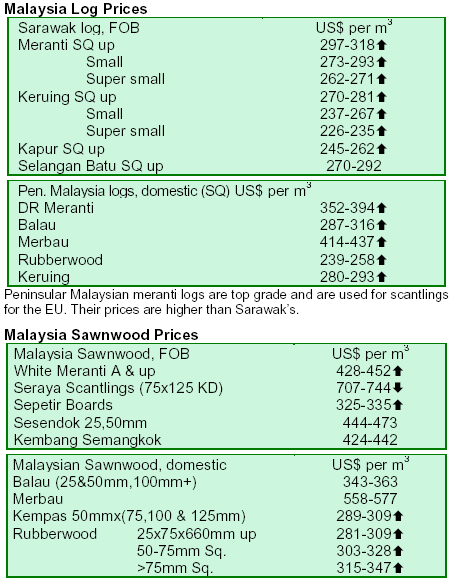
4.
INDONESIA
Indonesia and South Africa renew trade ties
Indonesia and South Africa have recently renewed their
commitment to increasing bilateral cooperation, reported
Antara News. Indonesian President Susilo Bambang
Yudhoyono visited South Africa in an effort to strengthen
trade ties between the two countries. Trade has been
expanding rapidly between South Africa and Indonesia
since 1994. MarketTradeNews noted the excellent
opportunities for continued cooperation in the forestry
sector, as Indonesia is a major producer of hardwood
solidwood products and pulp, while South Africa is a
world player in softwood production and the supply of
pulp.
Asmindo positive about furniture exports in 2008
The Indonesian Furniture and Handicraft Industries
Association¡¯s (Asmindo) said it held a positive outlook for
furniture exports in 2008, reported Antara News.
Asmindo¡¯s Chairman, Ambar Tjahyono, who was in China
attending the Shenzhen International Furniture Exhibition,
announced that Asmindo was confident that exports would
reach USD3 billion in 2008. This figure was 7% higher
than the figure for 2007. Tjahyono also said the Chinese
public were showing interest in Indonesia¡¯s furniture and
handicraft products at the International Furniture
Exhibition, where some Indonesian exhibits were sold in
bulk and long-term contracts.
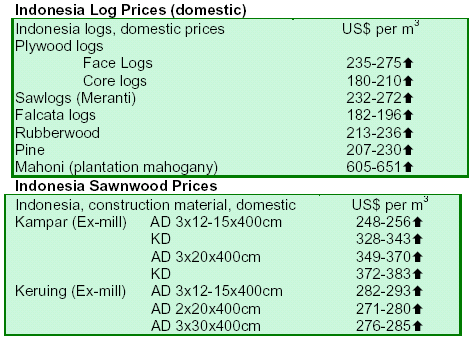
5.
MYANMAR
Trends show less than predictable tender prices
During the last two weeks, demand for teak remained
strong and higher grade teak logs had become less
available. As a result, many lower grades were sold in the
market. Sawlog grade 4 was the most popular type of teak
and preferred by many buyers because it is affordable and
diverse in use. Fairly high grade sawn timber, and in some
cases veneer flitches, can be obtained from these logs. The
following chart shows the pattern of tender prices over the
last six months:
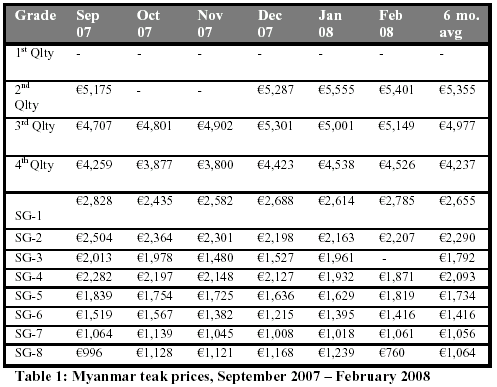
A steady decline in the price pattern is noted above.
Prices are dependent on available forest area, quantity of
logs available, grading and exchange rates. Some items
may be overpriced at times to respond to immediate
requests of buyers; corrections usually follow in the
market. Teak log prices are therefore difficult to forecast.
Since 2007, the Myanmar Timber Enterprise have sold
directly to buyers using six month tender average prices at
the time of shipment. Even though tender prices may
dramatically rise, tender average price leave little room for
maneuverability, although they are used by a number of
buyers from the East.
The traded volume of teak from Myanmar is very small
compared to the total global log trade. However, as
Myanmar is a major supplier of teak, it is expected to
remain a strong market player for some time. This also
applies to the sawn teak market. In the case of the sawn
teak market, however, local industry cannot cope with
demand due to the short supply of raw material and other
constraints. It has been reported that the offshore saw
millers and traders, especially from China and Vietnam,
are doing very good business in trading secondary
processed teakwood products.
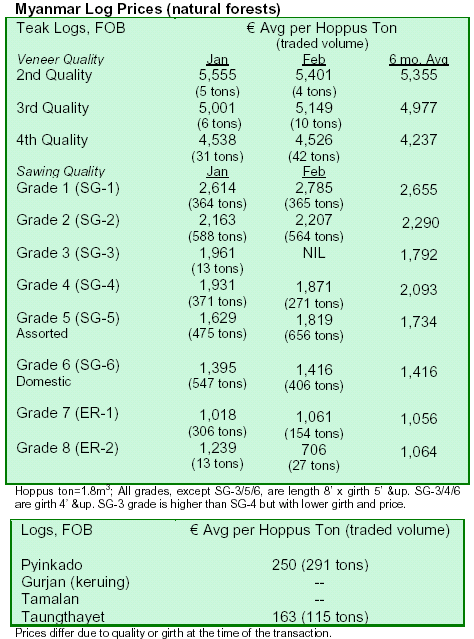
6.
BRAZIL
Prices rise slightly due to appreciation of Real
Prices of wood products in Brazilian Reals have remained
stable since mid-March. However, prices in US dollars
rose on average 2.72% due to the appreciation of the
Brazilian currency. The Committee on Monetary Policy
(Copom) had also maintained the prime interest rate
(Selic) at 11.25% per annum. This was the fourth
consecutive time that Copom has left the rate unchanged.
IBAMA teams step up illegal timber investigations
Continuing from reports in TTM 13:4 and 13:5 on Brazil¡¯s
illegal logging investigations, the Brazilian Institute of
Environmental and Renewable Natural Resources
(IBAMA) inspectors have conducted more raids on
suspected illegal logging sites since late February 2008.
IBAMA inspectors, in partnership with the Federal Police,
continued to investigate illegal logging activities in the
Tailandia municipality. As a result of these investigations,
three logging companies had been closed or discontinued,
since over half of their yards were piled with illegal logs
and one company was operating without a license.
IBAMA had collected fines from the illegal operators and
stopped all forestry operations where illegal activities were
uncovered.
The inspection team visited over 40 industrial units,
including logging companies, charcoal producers and
private properties. Among them, 39 were fined and 23 shut
down due to lack of proper documentation. Since the
beginning of the inspection, 16,400 m3 of timber (93%
logs and 7% sawnwood) without legal documentation was
seized. The total fine imposed on violators exceeded
BRL9 million. Inspectors also uncovered over 1,000 m3 of
charcoal produced without environmental licenses. Over
1,000 illegal charcoal ovens were destroyed, which is
equivalent to saving 60,000 small trees a month. Although
most of the ovens were destroyed by police and inspectors,
some were destroyed by the owners themselves to avoid
paying fines.
Brazil raises intake of US timber
Plugar reported that US timber and forest products
imports had increased in Brazil, opening up a new market
niche. According to the Ministry of Agriculture, Brazilian
imports of forest products and sawnwood increased 18.3%
and 164.3%, respectively, from 2005 to 2006. Since 2007,
the American Hardwood Export Council had been
working to promote the use and advantages of American
hardwoods to Brazilian companies. Timber products made
of cherry, red oak, white oak and maple are widely
exported but still have a small market share in Brazil.
Experts indicate that imports of American timber/veneer
can help Brazilian companies maintain or even expand
their participation in international markets.
According to the Association of Furniture Industry of Rio
Grande do Sul (MOVERGS), Brazilian companies are
encouraged to seek business opportunities involving the
use of American hardwood. Brazilian companies
importing raw materials can benefit from tax returns if
they re-export these goods. Furniture companies of the
southern state of Rio Grande do Sul have already carried
out studies on prices and quality of American hardwood
for possible import. MOVERGS observed that companies
need to import ¡®globalized products¡¯ to compete in the
globalized world. However, exporters should evaluate
production and competitiveness costs when targeting
foreign markets.
Sinop suffers drop in timber exports
Exports of Sinop, a major timber cluster in Northern Mato
Grosso, plunged in early 2008. The exported volume of
timber during the first half of January 2008 dropped 13%
compared to the first half of January 2007, according to
the Secretary of Foreign Trade. Despite the fall, timber
remains the main exported product of the region,
corresponding to 78% or USD5.4 million of the total sales.
According to S¨® Not¨ªcias, Belgium took most of Sinop¡¯s
exports, at USD2.1 million in value, followed by France
and the Netherlands. In 2007, Sinop exported USD69
million, a 27% gain from 2006 levels. The municipality
has substantially increased its foreign sales since 2000,
when sales reached USD26 million.
On the other hand, timber exports in Alta Floresta, another
major timber cluster in Northern Mato Grosso, increased
10% in the first half of January 2008 compared to the
same period in 2007. Timber exports reached USD1.6
million in January 2008 and dropped to USD1.2 million in
February 2008. Sawnwood and processed solidwood
product sales to the US were USD1.3 million in value, or
approximately 98% of exports, Spain received 25%, and
Israel 15%. In 2007, Alta Floresta exported USD20.9
million worth of sawnwood and processed solidwood
products, 30% more than in 2006.
Brazil furniture exports leap 7.2% in early 2008
MDIC/CGI Moveleiro show early estimates of furniture
exports at USD141.2 million in the first half of January
2008, increasing 7.2% compared to the same period of
2007. Brazilian exports of furniture to the US in the period
reached USD17.8 million, dropping 34.5% compared to
2007. On the other hand, exports to Argentina rose 52.6%,
equivalent to USD13.2 million. Exports to France
represented USD12.9 million, jumping 38.4% in
comparison to the value of exports in 2007.
Rio Grande do Sul is the leading furniture exporting state
in Brazil, representing gains of USD42.6 million between
January and February 2008, a 13.8% increase compared to
the same period in 2007. However, exports to the UK, the
major importer of furniture from Rio Grande do Sul
dropped 16.6% and exports to the US fell 42%. Furniture
imports of Mexico and Argentina from Rio Grande do Sul
surged 96.4% and 74%, respectively. The neighboring
state of Santa Catarina exported USD48.2 million during
the period, which represented a 4.8% drop from the same
period in 2007.
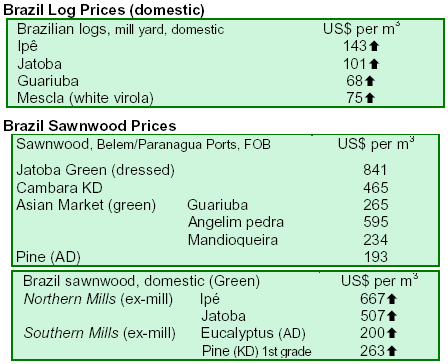
7. PERU
Penalties to be raised under US-Peru FTA
Early this year, an American delegation composed of
environment and intellectual property specialists visited
Peru twice to monitor progress on its forest policy
development. American officials were interested in
implementation arrangements under the US-Peru Free
Trade Agreement (FTA), which was signed in 2007.
During the visit, the Peruvian Foreign Commerce Ministry
and Coordinator, Silvia Hooker, noted that policy reform
measures were being undertaken to increase penalties for
those who participate in illegal logging. For instance, the
jail sentence for those found guilty of illegal logging has
been increased from three to fifteen years.
In addition to progress made on forest policy reform, it
was determined that the Ministry of Agriculture would
oversee forest resource management and the Ministry of
Environment would be responsible for protected area
management. It was also recommended that OSINFOR,
the supervisory body of forest concessions, would act as
an independent entity. Moreover, Peru would work to
apply reforms in the forest sector 18 months after the FTA
enters into force and continue to promote transparency in
the amount of mahogany harvested.
ADEX establishes Forest Committee
The Forest Products Committee of the Exporters
Association (ADEX) oversees forest management, the
manufacturing of wood products, national trade and
country exports in Peru. ADEX has now created a Forest
Committee to monitor its work. The Forest Committee
recently published a Code of Ethics under which all forest
operators to be responsible for efficient, responsible,
sustainable management and manufacturing. By
complying with the Code, they express their commitment
to the implementation of international laws and treaties.
Reforestation law aims recovery of 100K hectares a year
Antonio Egg Brack of the Peruvian Ministry of
Environment recently explained inroads in Peru¡¯s law for
the promotion of private investment in reforestation and
agroforestry. He explained that about 100 thousand
hectares a year could eventually be reforested under the
law. However, he expected all cultivation activities under
the initiative to take about four years. The initiative would
help forest cultivation in degraded and arid lands of
coastal, highland and jungle regions, so as to recover large
natural forest areas. The initiative will delegate to regional
authorities the privilege to determine concession areas for
forest plantations. Plantation establishment would need to
be considered a long-term endeavor even if the concession
is leased for a short period of time. Brack Egg noted the
case of Chile, where 2.2 million hectares were reforested
over a time span of 30 years.
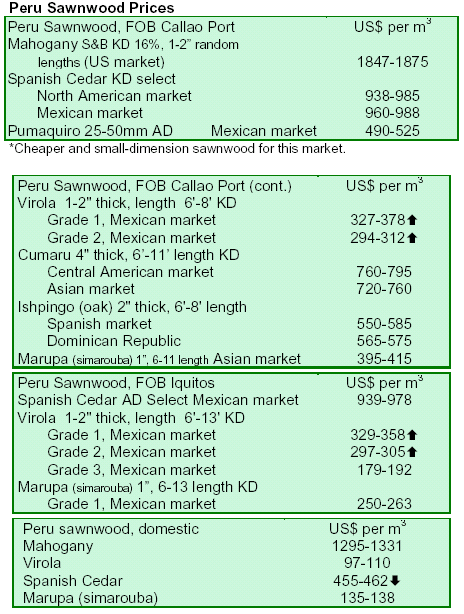
8. BOLIVIA
Fourth Business Roundtable attracts over 180
participants
Over 180 participants have registered for the Fourth
Business Roundtable on the Wood Industry in Bolivia,
which will be convened by the Forest Chamber of Bolivia
(CFB) with the support of ITTO and the US Agency for
International Development. The Roundtable, which will be
held from 27-28 March 2008, will host participants from
over 14 countries, half of which are international
companies that purchase wood and suppliers of machinery
and supplies for the forest industry. Other participants
include national companies and small business owners,
forest operators from indigenous communities and
members from the financial and tax services sectors. The
number of registered participants at the forthcoming
Roundtable has already exceeded the number of
participants at the 2007 Roundtable. The Roundtable is
expected to generate prospective business deals worth
approximately USD21 million dollars.

9. GUYANA
Guyana gains from higher value-added products and
wider markets
Stringent efforts by policy makers and other stakeholders
to increase value-added production and exports have made
significant progress. After two months and a half into
2008, value-added exports are largely on track and have
exceeded the value of exports during the same period in
2007 by 20%.
Thus far, there has been marked improvement in exports
of furniture with current export value to the UK, the main
export market, already valued at more than a third of last
year¡¯s exports. Similarly, dressed sawnwood exports were
nearly one third of the total 2007 value. Plywood exports,
to the end of February 2008 remained roughly equal to
that for the same period last year, but are expected to pick
up following a restart in plywood production in March.
There has also been a widening of export markets with
greater exports to new markets outside of the Latin
American and the Caribbean region. Gains in already
established markets have also continued to rise. This is the
result of the collective efforts of industry stakeholders,
including manufacturers, and the Guyana Forestry
Commission to promote Guyanese forest products.
Notable gains in the recent past include increased exports
of dressed lumber to high value destinations such as
Barbados and New Zealand, shingles to Mauritius and
furniture to the UK.
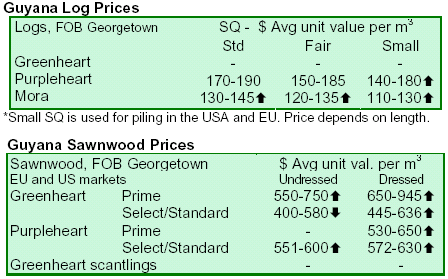
|